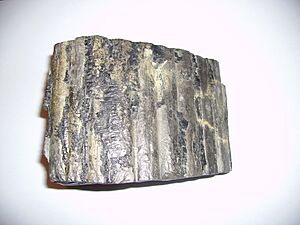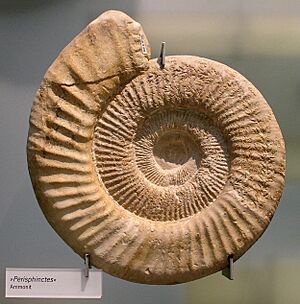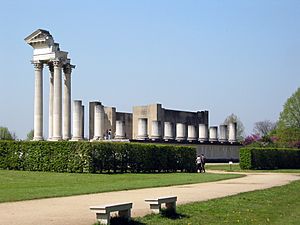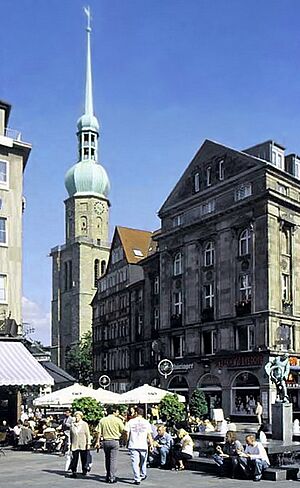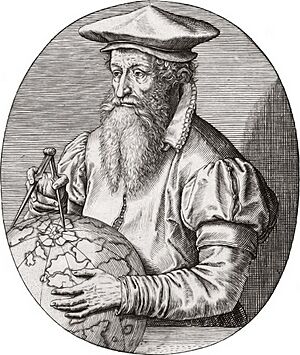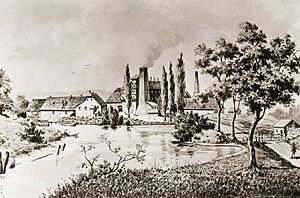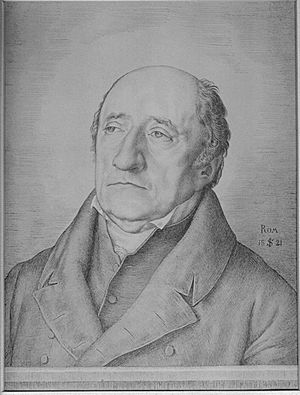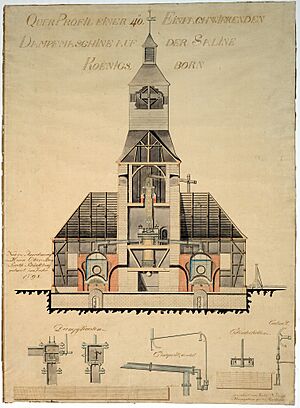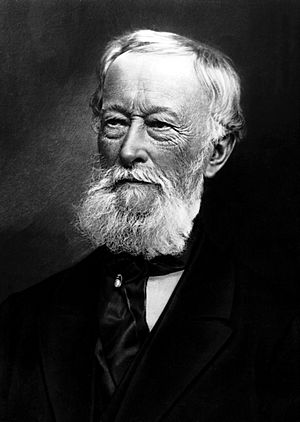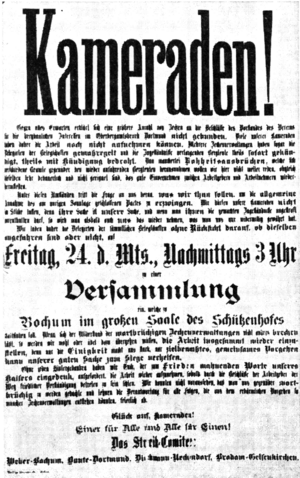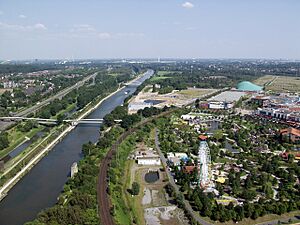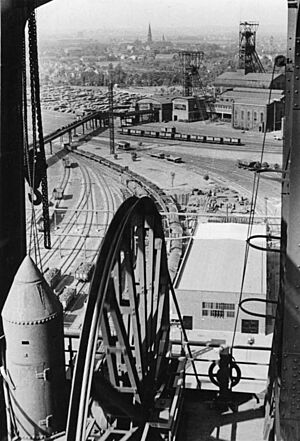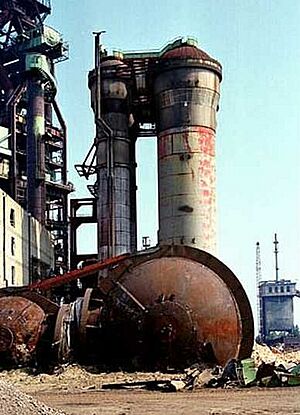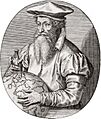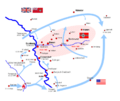History of the Ruhr facts for kids
The Ruhr region in Germany is a famous industrial area. Its exact borders can change a bit depending on who you ask. But generally, it's between the Lippe River in the north and the Ruhr River in the south. The Rhine River forms its western edge, and the town of Hamm is its eastern limit.
Long ago, in the Middle Ages, powerful counts ruled different parts of the Ruhr. The Archbishop of Cologne controlled the land west of the Rhine. An important trade route called the Hellweg crossed the region, connecting towns like Duisburg and Dortmund. Many of the most important towns grew up along this route.
After the Congress of Vienna in 1815, the entire Ruhr area became part of Prussia. This happened just as the region was starting to become one of the world's most important industrial centers. In 1946, the state of North Rhine-Westphalia was created, with the Ruhr at its heart. Today, the coal and steel industries that made the Ruhr famous have shrunk a lot, and the region is changing.
Contents
- Ancient Times: Earth's History in the Ruhr
- Early Humans in the Ruhr
- The Middle Ages: Abbeys, Towns, and Conflicts
- Early Modern Period: Reformation and Wars
- Prussian Absolutism: Industry Begins to Grow
- First Half of the 19th Century: The Industrial Revolution Takes Off
- Second Half of the 19th Century: The Industrial Boom
- First Half of the 20th Century (to 1945): World Wars and Occupation
- Second Half of the 20th Century (from 1946): Recovery and Decline
- 21st Century: Transformation and New Challenges
- See also
- Images for kids
Ancient Times: Earth's History in the Ruhr
The Carboniferous Period: When Coal Was Born
About 360 to 300 million years ago, during the Carboniferous Period, thick layers of slate, coal, and sandstone formed in the Ruhr. This was a time when new mountains were also rising up.
During a part of the Carboniferous called the Silesian period, layers of plant material and mud were laid down. Over millions of years, these layers turned into the coal seams we see today, separated by layers of stone. This happened because the area kept switching between being a marshy swamp and being covered by the sea.
Giant tree-like plants, like Lepidodendron and Sigillaria, grew in these ancient coal marshes. These plants could reach heights of up to 40 meters (about 130 feet) and had trunks over a meter (about 3 feet) wide!
The Cretaceous Period: Under a Tropical Sea
Around 135 to 66 million years ago, in the Cretaceous Period, the Ruhr region was covered by a warm, tropical ocean. Amazing creatures called ammonites lived in these waters. On the seafloor, a thick layer of marl (a type of soft rock) formed. This sediment covered the older coal layers and also contained the shells of huge ammonites.
The Quaternary Period: Ice and Meltwater
The Ice Age brought big changes, with periods of warm and cold weather. During one stage, a huge ice sheet covered northern Germany, reaching into the Ruhr valley. The powerful force of this ice and its meltwater carved out the shape of the middle and lower Ruhr valley. Meltwater from the glaciers flowed west through the Ruhr valley. Near where Essen is today, ice and rocks temporarily blocked this flow, creating a massive lake that filled the valley all the way to Schwerte.
Early Humans in the Ruhr
Pre-history: Ancient Settlements and Tools
- Around 80,000 BC – The Ruhr region was already home to Neanderthals. When the Rhine-Herne Canal was built in 1911, workers found stone tools and traces of ancient camps in Herne. These sites also contained bones from woolly rhinoceros, bison, and mammoth. Similar discoveries were made in Bottrop in the 1960s.
- Around 8700 BC – In 1978, Stone Age flint tools were found on the Kaiserberg in Duisburg. These tools date back to the end of the last Ice Age. The oldest remains of modern humans in the Ruhr were found in 2004 in the Blätterhöhle cave in Hagen-Hohenlimburg.
- 6000–4500 BC – During the Neolithic period, several settlements existed in areas like Bochum, Hagen, and Dortmund. In 2004, skeletons from the Michelsberg culture were found in the Blätterhöhle cave, including a young woman's skeleton. These finds are very important for understanding ancient burials in the Rhine-Ruhr area.
Antiquity: Romans and Franks
- 100 BC – Germanic tribes, like the Sicambri, threatened the Celtic people living here.
- 12 BC – The Romans built military camps, including Asciburgium near modern-day Moers and Duisburg, and Vetera near Birten.
- 1 BC – Roman military bases were set up along the Lippe River. The most important was at Haltern. After a major defeat in 9 AD (the Battle of the Teutoburg Forest), the Romans pulled back to the west bank of the Rhine.
- 69 AD – The Revolt of the Batavi led to the destruction of Roman camps like Asciburgium and Vetera.
- 110 AD – The Roman town of Colonia Ulpia Traiana, near modern-day Xanten, received full Roman town rights.
- 275 AD – Frankish attacks heavily damaged Colonia Ulpia Traiana. A strong fortress called Tricensimae was built in its place.
- 407 AD – The Western Roman Empire gave up its control of the Rhine border.
- Around 420 AD – The first signs of Frankish settlement appeared in Duisburg, right on the Rhine River as it flowed then.
- 556 AD – Conflicts began between the Franks and the Saxons.
The Middle Ages: Abbeys, Towns, and Conflicts
Early Middle Ages: Christian Missions and Viking Raids
- Late 7th Century – Christian missionaries from France tried to convert people in the region, but Saxon settlers slowed this down. A famous story tells of two missionaries, Black Ewald and Fair Ewald, who were killed in Aplerbeck in 695.
- 775 AD – The army of the Franks, led by Charlemagne, conquered important strongholds like the Sigiburg.
- 796 AD – Liudger founded Werden Abbey, an important monastery.
- 863 AD – Normans (Vikings) spent the winter on Bislich Island near Xanten and destroyed the local church.
- 870 AD – The abbey church at Essen Abbey, founded by the Saxon noble Altfrid, was officially opened.
- 883 AD – Normans sacked Birten. A report says Normans spent the winter in oppidum diusburh (Duisburg) after conquering it. Burg Broich in Mülheim an der Ruhr was built, likely to protect against these Viking raids and guard a crossing point over the Ruhr River.
- 929 AD – An important church meeting (synod) was held in Duisburg. Between 922 and 1016, kings stayed in Duisburg 18 times, showing its importance.
- 941 AD – Otto I (the Great) visited Dortmund for the first time. Both Dortmund and Duisburg were important royal residences along the Hellweg trade route.
High Middle Ages: Growth and Power Struggles
- 1000 AD – Churches in the Romanesque style began to be built, like the Stiepeler Dorfkirche.
- 1041 AD – Essen received the right to hold a market, which helped its economy grow.
- 1122 AD – Count Gottfried of Cappenberg founded the first Premonstratensian monastery in Germany, Cappenberg Abbey in Selm. He gave his castle and wealth to the new religious order.
- 1145 AD – The Knights Hospitallers opened their first German branch near Duisburg, building the Marienkirche (church).
- 1160 AD – The County of Mark was created, becoming an important local power.
- 1173 AD – Emperor Frederick Barbarossa allowed Duisburg to hold two large cloth fairs each year, boosting its trade.
- 1200 AD – Large town walls were built around Dortmund. You can still see traces of their path in the city today.
- 1225 AD – The murder of the Archbishop of Cologne led to the execution of Frederick of Isenberg. Much of his land went to the Count von der Mark. This event led to the founding of Hamm in 1226, which received town rights.
- 1244 AD – The people of Essen and the local abbey worked together to build the Essen Town Walls.
- 1248 AD – The important cities of Dortmund and Duisburg joined forces with 'anti-king' William II of Holland.
Late Middle Ages: Leagues and Black Death
- 1253 AD – Towns like Dortmund, Soest, and Münster formed the Werne Federation, a group that was a forerunner of the powerful Hanseatic League. Dortmund quickly became a leader for Westphalian towns in this league.
- 1283–1289 AD – The War of the Limburg Succession weakened the power of the Archbishop of Cologne. This allowed local counts, especially those of Berg and Mark, to become even stronger.
- 1290 AD – Duisburg came under the control of the Duchy of Cleves.
- 1321 AD – Count Engelbert II of the Mark granted Bochum town rights.
- 1350 AD – The terrible Black Death plague reached the Ruhr region.
- 1371 AD – The founding of Ruhrort began with the building of a toll-booth.
- 1388–1389 AD – The Great Dortmund Feud saw Dortmund trying to become more independent, but it ended up deeply in debt.
- 1396 AD – The first written mention of wild horses in the Emscher valley appeared.
- 1398 AD – The County of Cleves and the County of Mark were united under one ruler.
- 1403 AD – The Wildungen Altar, a famous artwork by Dortmund artist Conrad von Soest, was completed.
- 1424 AD – Hattingen was almost completely burned down during a war between two brothers.
- 1444–1449 AD – The Soest Feud involved towns like Dorsten and Recklinghausen. Dortmund's stone tower was damaged during this conflict.
- 1486 AD – A special tax was agreed upon in the County of Mark, providing valuable records about the region.
Early Modern Period: Reformation and Wars
- 1518–1519 AD – A conflict broke out in Dortmund between citizens and the clergy over special privileges, connected to the start of the the Reformation.
- 1521 AD – The Duchy of Cleves-Mark gained control of Jülich and Berg through inheritance.
- 1529 AD – The Sweating sickness epidemic hit Dortmund hard, killing many people very quickly.
- 1541 AD – Printing was introduced in Wesel, and two years later in Dortmund, making it an important printing center.
- 1543 AD – Dortmund founded a humanist grammar school, influenced by schools in Emmerich and Münster.
- 1552 AD – The famous map-maker, Gerhard Mercator, settled in Duisburg. He found the Duchy of Cleves a liberal place to work.
- 1559 AD – The Schola Duisburgensis became the Gymnasium Duisburg. Mercator taught mathematics there.
- 1568 AD – Uprisings in the nearby Netherlands marked the start of the Eighty Years' War.
- 1580 AD – Witch trials reached a peak in Vest Recklinghausen, with many people, mostly women, being executed.
- 1583–1589 AD – The Cologne War caused great suffering in the Vest Recklinghausen region.
- 1587 AD – Dutch-controlled Ruhrort was captured by Spanish troops.
- 1598 AD – Spanish troops entered the Ruhr, plundering areas around Dortmund. The region suffered greatly from the Eighty Years' War.
- 1599 AD – The plague broke out in Dortmund due to Spanish troop movements.
- 1609 AD – The War of the Jülich succession began, leading to Brandenburg and Pfalz-Neuburg jointly managing the Duchy of Cleves.
- 1614 AD – The land of the last Duke of Jülich-Cleves-Mark was divided. Prussia gained Cleves and Mark.
- 1618–1648 AD – The Thirty Years' War devastated the region. Dortmund was forced to pay large sums of money and did not regain its former size until the Industrial Revolution.
- 1620 AD – Essen's arms manufacturing reached its peak, producing about 15,000 rifles and pistols annually.
- 1629 AD – In Amt Werne, 30 people were victims of a witch hunt.
- 1632 AD – General Gottfried Heinrich Graf zu Pappenheim occupied Dortmund but spared it from burning in exchange for a ransom.
- 1647 AD – A rare witch trial in the County of Mark led to the execution of a peasant.
- 1648 AD – The Treaty of Westphalia officially ended the Thirty Years' War and the Eighty Years' War. However, Dortmund remained occupied for two more years.
Prussian Absolutism: Industry Begins to Grow
Large parts of the Ruhr came under Prussian control. This period saw the start of ironworks and a boost in coal mining. The Prussian state actively encouraged industry.
- 1655 AD – Brandenburg temporarily controlled the Duchy of Cleves, and a university was founded in Duisburg.
- 1666 AD – The Duchy of Cleves and the County of Mark permanently became part of Brandenburg.
- 1672 AD – French soldiers invaded the region during the Franco-Dutch War, burning down buildings like the Haus Steinhausen.
- 1716 AD – The local government in Ruhrort decided to build a harbor, which was the beginning of the huge Duisburg-Ruhrort Harbour we know today.
- 1734 AD – The Königsborn Saltworks in Unna was founded by the Prussian state.
- 1738 AD – The Mark Mining Office was founded in Bochum.
- 1758 AD – On October 18, a new blast furnace at the St Antony Smeltery in Osterfeld (now Oberhausen) was used for the first time. This was the first time iron was produced from ore in the region.
- 1766 AD – King Frederick II issued new rules for mining.
- 1780 AD – The construction of 16 locks on the Ruhr River was completed, making the river navigable for ships, mainly for transporting coal. This was very important for the early coal industry.
- 1781 AD – The Gute Hoffnung Smeltery was founded in Sterkrade (now Oberhausen). It later came under the control of the Krupp family.
- 1784 AD – Henry Frederick Karl Freiherr vom und zum Stein became director of the mining office in Wetter an der Ruhr. He strongly supported the development of mines and ironworks.
- 1787 AD – The Rauendahler Schiebeweg was opened in Sundern. This was the first horse-drawn railway in the Ruhr valley, used to transport coal from mines to the river.
- 1794 AD – The French army occupied the left bank of the Rhine.
- 1799 AD – A steam engine was used for the first time at the Königsborn Saltworks in Unna-Afferde. This new technology greatly increased salt production.
First Half of the 19th Century: The Industrial Revolution Takes Off
The Industrial Revolution really began to change the Ruhr. Steam engines appeared, and old feudal systems were abolished. When the whole area became Prussian in 1815, transport and industry grew even more. By the 1830s, important deep coal seams were reached, railways started appearing, and by 1849, iron was successfully smelted using coke.
- 1801 AD – The first imported steam engine in the Ruhr mines was used to pump water out of the Vollmond Mine in Werne.
- 1802 AD – Prussian troops occupied the former religious territories of Essen and Werden.
- 1806–1813 AD – The Napoleonic Grand Duchy of Berg existed. The French abolished tolls on the Ruhr and Rhine rivers, which helped river traffic.
- 1808 AD – Napoleon issued a decree that abolished serfdom, freeing peasants from being tied to the land.
- 1809 AD – Napoleon introduced freedom to engage in a trade, and old guilds were dissolved.
- 1811 AD – In Essen, Friedrich Krupp founded a steel foundry. Although it struggled at first, it laid the groundwork for the later successful Krupp company.
- 1815 AD – After the Napoleonic Wars, the Vienna Congress returned the Ruhr to Prussia. This meant all the territories in the Ruhr, Emscher, and lower Rhine were now under one government.
- 1816 AD – The Year Without a Summer brought hunger to the region.
- 1816 AD – The Bochum Mining College was founded to train mining leaders.
- 1819 AD – Friedrich Harkort started his "Mechanical Workshops" in Wetter an der Ruhr, building steam engines.
- 1828 AD – Franz Haniel opened a shipyard in Ruhrort to build steamers.
- 1837 AD – The Kronprinz Mine successfully drilled through the overlying chalk layer to reach deeper coal seams for the first time.
- 1839 AD – New regulations limited child labor in factories: children had to be at least nine years old and could work no more than ten hours a day.
- 1839 AD – The Gutehoffnung Smeltery built its first steam locomotive, named Ruhr.
- 1847 AD – The Cologne-Minden Railway opened. This railway was crucial for the Ruhr's industrial growth, connecting major towns like Duisburg, Oberhausen, Gelsenkirchen, and Dortmund.
- 1849 AD – For the first time in the Ruhr, coke was used for steel production at the Frederick William Smeltery in Mülheim.
Second Half of the 19th Century: The Industrial Boom
The Ruhr's industries grew rapidly. Coal production jumped from 2 million tonnes in 1850 to 114 million tonnes in 1913. Iron production also soared. Mines moved north as new technology allowed access to deep coal seams. Companies often owned collieries, cokeries, and ironworks together, sometimes all on the same site.
- 1854 AD – The Henrichshütte was founded in Hattingen.
- 1855 AD – The first shaft of the Hibernia Mine in Gelsenkirchen began to be dug, using new technical methods.
- 1857 AD – An economic crisis led to a drop in sales for coal and steel, affecting workers.
- 1858 AD – The Association for Mining Interests was founded in Essen.
- 1862 AD – A second important railway line, the Witten/Dortmund–Oberhausen/Duisburg railway, opened, connecting the east and west of the Ruhr.
- 1867 AD – August Thyssen founded an ironworks in Duisburg.
- 1869 AD – The industrialist Alfred Krupp began building the magnificent Villa Hügel in southern Essen, his family home.
- 1870–1871 AD – Germany won the Franco-Prussian War, leading to the founding of the German Reich.
- 1871–1873 AD – The "Gründerjahre" (founding years) saw a building boom, with many new mining companies created using money from French war payments.
- 1873 AD – A crisis hit due to financial speculation, causing steel production to drop.
- 1889 AD – A huge strike of miners spread across the entire Ruhr. Workers demanded a share in company profits. The first permanent miners' union was founded in Dortmund-Dorstfeld.
- 1892 AD – The Grillo Theatre opened in Essen.
- 1893 AD – The Rhenish-Westphalian Coal Syndicate was formed in Essen to control coal production, marketing, and prices.
- 1893 AD – Essen saw its first electric tram begin operating.
- 1898 AD – The Rheinisch-Westfälischen Elektrizitätswerke (RWE), a major electricity company, was founded.
- 1899 AD – The Dortmund-Ems Canal was opened, with Emperor William II attending the opening of the port of Dortmund. This canal became very important for transporting imported iron ore.
First Half of the 20th Century (to 1945): World Wars and Occupation
The coal and steel industries continued to grow, making the Ruhr a major industrial powerhouse. However, this period also brought devastating wars and occupations.
- 1904 AD – Otto Heinrich Flottmann from Herne received a patent for the pneumatic drill. This new tool greatly increased coal extraction.
- 1905 AD – A region-wide strike helped miners win a maximum 8-hour workday.
- 1912 AD – Another miners' strike occurred across the Ruhr. Emperor William II sent in troops, and the workers eventually gave up.
- 1913 AD – Laws were introduced to clean up the Ruhr River and regulate its dams, helping to ensure water supply for the growing population.
- 1914 AD – The Rhine-Herne-Canal opened, becoming Europe's most-used inland canal. It connected the Rhine at Duisburg to Herne and the Dortmund-Ems Canal.
- 1914–1918 AD – During World War I, the Ruhr's inhabitants suffered greatly from food shortages, especially in the "Hunger Winter" of 1916–17.
- 1919 AD – Large-scale socialist uprisings in the Ruhr led to armed conflicts between miners and volunteer military groups.
- 1920 AD – The Ruhr Uprising followed a failed coup attempt. A general strike turned into a military struggle involving the Red Ruhr Army.
- 1921 AD – French and Belgian troops occupied Duisburg (and Düsseldorf) because Germany failed to make reparation payments.
- 1923 AD – The occupation was extended to the rest of the Ruhr (Occupation of the Ruhr). This led to hyperinflation and strikes.
- 1924 AD – The Allies ended the occupation of the Ruhr.
- 1925 AD – Dortmund Airport opened, becoming a stop on a major European air route.
- 1926 AD – The Wedaustadion in Duisburg officially opened. It was Germany's second-largest stadium at the time.
- 1928 AD – Many towns in the Ruhr merged or changed their boundaries, creating "double-towns" like Gelsenkirchen-Buer and Duisburg-Hamborn.
- 1929 AD – The Oberhausen Gasometer, Europe's largest gas holder, was completed.
- 1929 AD – The start of the global economic crisis caused the coal and steel industries to collapse.
- 1932 AD – The Great Depression hit its peak, with unemployment in the Ruhr reaching 31.2%.
- 1933 AD – The National Socialists (Nazis) took power. The Steinwache in Dortmund became a Gestapo prison and torture chamber.
- 1936 AD – Jewish business owners, like Gebr. Alsberg, had their properties taken away.
- 1938 AD – During Kristallnacht, synagogues in most Ruhr towns were destroyed. The Old Synagogue in Essen was too strong to blow up without damaging surrounding buildings, so it remained standing, though its interior was burned.
- 1938 AD – The Chemischen Werke Hüls was founded in Marl, producing synthetic rubber for tires. Forced labor was used here during the Nazi era.
- 1939 AD – World War II began.
- 1943 AD – Allied bombing raids destroyed over 65% of houses in cities like Dortmund and Duisburg. Thousands of people died.
- 1943 AD – On May 18, the Möhne Dam was bombed and breached by the Royal Air Force. A flood wave raced down the valleys, killing over 1,000 people, mostly foreign forced laborers and prisoners of war.
- 1945 AD – The fighting in the Ruhr Pocket resulted in about 105,000 deaths.
- 1945 AD – The arms manufacturer Alfried Krupp von Bohlen und Halbach was arrested by American troops.
- 1945 AD – At the Potsdam Conference, it was decided that the Ruhr would remain part of Germany, despite France's wishes for a special status.
Second Half of the 20th Century (from 1946): Recovery and Decline
After the war, industry in the Ruhr was rebuilt. However, by the end of the century, the coal and steel industries had drastically declined.
- 1946 AD – The state of North Rhine-Westphalia was founded by the British military government, with the entire Ruhr region within its borders.
- 1946–1947 AD – The "hunger winter" severely affected the Ruhr population. Many people traveled to farming regions to trade goods for food.
- 1948 AD – Strikes grew due to food shortages. A currency reform in June made goods more available but reduced the value of money for working-class families.
- 1949 AD – The Ruhrstatut regulated control of coal and steel production. This control ended with the founding of the European Coal and Steel Community in 1952.
- 1952 AD – The Westfalenhalle in Dortmund was rebuilt after wartime destruction and officially reopened.
- 1954 AD – The annual short-film festival took place for the first time in Oberhausen.
- 1956 AD – Demand for coal reached its peak, and the number of workers in Ruhr mining reached its highest point at 494,000.
- 1957 AD – At Bochum Observatory, Heinz Kaminski received radio signals from Sputnik 1, possibly the first outside the Soviet Union.
- 1959 AD – Bochum miners protested against cheap American coal imports. This marked the beginning of the "death of the mines" (Zechensterben).
- 1962 AD – An Opel car factory opened in Bochum.
- 1963 AD – The Bundesliga (German football league) was inaugurated, with three clubs from the Ruhr: Schalke 04, Meidericher SV (now MSV Duisburg), and Borussia Dortmund.
- 1964 AD – A proposal suggested closing 31 large mines, leading to demonstrations.
- 1965 AD – The Ruhr University in Bochum opened, the first university in the Ruhr region.
- 1966 AD – Borussia Dortmund won the European Cup Winners Cup.
- 1967 AD – Krupp was converted into a corporation.
- 1968 AD – The University of Dortmund was founded.
- 1969 AD – The Ruhrkohle AG (Ruhr Coal AG) was founded.
- 1972 AD – The universities of Essen and Duisburg were founded (they later merged in 2003).
- 1973 AD – The RheinRuhrZentrum opened in Mülheim an der Ruhr, Germany's first indoor shopping center.
- 1974 AD – The World Cup was held in Germany, with games played in new stadiums in Gelsenkirchen and Dortmund.
- 1975 AD – Bochum and Duisburg expanded their city limits, and Herne and Wanne-Eickel were united.
- 1977 AD – The steel crisis led to the loss of 200,000 jobs in the Ruhr.
- 1979 AD – The first Smog alarm was issued in the Ruhr.
- 1980 AD – The Old Synagogue in Essen became a memorial.
- 1982 AD – Steelworkers protested against closures and layoffs. The last blast furnace between Duisburg and Dortmund closed in Gelsenkirchen.
- 1984 AD – The first U-Bahn (subway) line opened in Dortmund.
- 1985 AD – A highest-level smog warning was issued in the western Ruhr.
- 1986 AD – A serious accident at the Hamm-Uentrop atomic power station caused a radioactive cloud over Hamm and the Ruhr.
- 1989 AD – The Internationale Bauausstellung Emscher Park (IBA Emscher Park) began its work, focusing on transforming the industrial landscape.
- 1992 AD – The Kokerei Kaiserstuhl in Dortmund, one of Europe's most modern coking plants, opened but only operated for eight years.
- 1993 AD – The first Mayday music festival took place in the Westfalenhalle, becoming a major techno event.
- 1994 AD – An EU-Summit was held in Essen, discussing unemployment and equal opportunities.
- 1995 AD – The Ruhr became part of the new European metropolitan area Rhine-Ruhr.
- 1996 AD – The CentrO shopping center opened in Oberhausen, built on the site of a former ironworks. It became a symbol of the Ruhr's economic change.
- 1997 AD – The Nordstern Mine grounds in Gelsenkirchen were transformed into the Nordsternpark.
- 1999 AD – The IBA Emscher Park project concluded, showcasing new uses for the Inner Harbour in Duisburg.
21st Century: Transformation and New Challenges
- 2004 AD – The Kommunalverband Ruhrgebiet (KVR) was replaced by the Regionalverband Ruhr (RVR), which gained more power, including authority over major projects like the underground Emscherkanal.
- 2004 AD – Adam Opel AG planned to cut thousands of jobs in Bochum, leading to a large strike.
- 2005 AD – The Hartz IV reforms affected almost a million people in the Ruhr.
- 2005 AD – The 7th World Games took place in Duisburg and neighboring cities.
- 2006 AD – Essen was chosen as the European City of Culture for 2010. Dortmund and Gelsenkirchen hosted games during the World Cup.
- 2007 AD – The German government announced plans to subsidize the coal industry until 2018, but the state government said its aid would stop in 2015.
- 2007 AD – The Loveparade music festival moved to the Ruhr.
- 2008 AD – The Nokia factory in Bochum closed. The Loveparade in Dortmund set a record with 1.6 million participants.
- 2009 AD – Opel faced a crisis after its parent company, General Motors, went bankrupt.
- 2010 AD – Essen and the Ruhr region celebrated being the European Capital of Culture.
See also
- Timeline of Essen history
Images for kids


